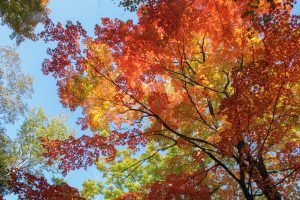
By Emily Lepkowski
April 20, 2016
Whitewater Urban Forestry Commission (UFC) member Anne Zarinnia and UFC chair Karen Coburn remember a time when you could drive down Main Street and a canopy of Elm trees covered the street.
It’s because of that canopy that the UFC is inviting Whitewater residents and students to take part in their first-ever tree and notable tree nomination survey.
The survey is comprised of three parts. One is asking people what they believe to be true about the function of trees, such as if they increase property value or reduce stress.
The other two parts of the survey ask people what they would like to learn about trees. It also seeks input on areas like schools or parks and what community members want to see in them, such as more fall color or shade.
The UFC advises the City Forester and several other committees on which kind of trees should be planted, the conditions of existing trees and restoring vegetation from invasive species.
“The big push right now is for us to get a tree survey done,” Zarinnia said.
The UFC was inspired by Fitchburg, Wisconsin, in terms of surveying and picking out notable trees, which must qualify with the state’s age, height and canopy requirements.
“Looking at the size of Whitewater compared to the size of Fitchburg, we decided to do two things,” Zarinnia said. “A tree survey where people can tell us what trees they have and a second survey for people to say I’ve got this fabulous tree on my terrace or in my backyard.”
The committee’s use of Geographic Information System or a GIS map, played a large role in developing the survey.
The use of the GIS map is what ‘makes the survey possible in essence because that is the only way it [trees] gets mapped, Zarinnia said.
The map shows trees in the community and identifies them with a database in order to show what kind of species the trees are.
Involvement
Part of the motivation for the tree survey is to help protect Whitewater’s Tree City status.
“I think people are realizing what we will lose if we lose our trees,” Coburn said.
Groups from UW-Whitewater have helped gather information on trees in the community in the past.
However, the UFC is now looking to the university and residents for their two cents on trees in the community.
“I think it’s important to ask people what they would like, so that’s what we’ve done,” Zarinnia said.
The movement for the tree survey this past fall after Zarinnia recognized a collaboration is key for making a difference in Whitewater.
The UFC saw that not much larger of a population in Fitchburg completed the survey and used their survey turnout to see how they can reach more involvement in Whitewater.
Zarinnia also reached beyond Whitewater, looking other cities and even countries to see what other places were doing in terms of tree conservation and growth efforts.
“The biggest value of the survey is going to be public education and engagement in looking at trees and taking charge of the trees in the city,” Zarinnia said. “It’s really a process of engaging the public in the awareness of their own community.”
The UFC also looks to the university to understand the need of trees in Whitewater, noting that while the campus has a lot of trees, there used to be more.
“The university is part of us, so they need to be part of the survey,” Zarinnia said.
The UFC also offers short term positions on smaller committees for students who wish to get involved with the city and its environment.
The tree survey can be found at surveymonkey.com/r/FLWSKBK
The notable tree form can be found at www.surveymonkey.com/r/CY5FSYM
Copies of the survey are also available at the Anderson Library.

